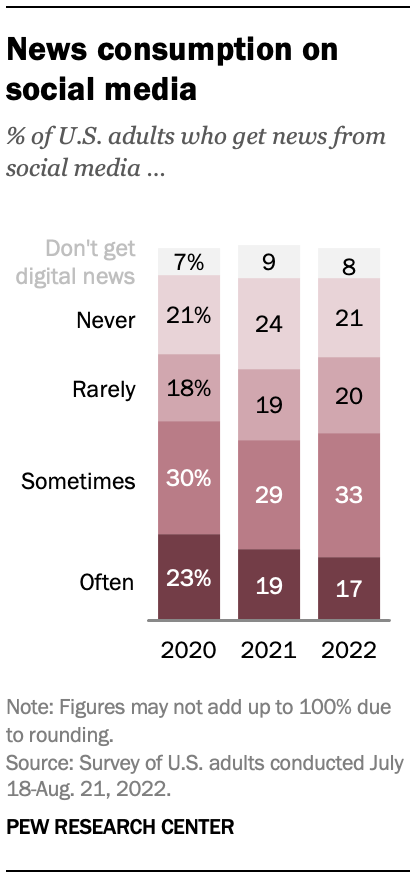
Journalism faces various challenges in today’s digital age, meaning identifying reputable brands is more important than ever. The rise of fake news has muddied the waters, making it difficult for readers to differentiate between verified facts and misleading information. The omnipresence of social media has also transformed news consumption patterns. In 2022, 33% of US adults sometimes got their news from social media:

Source: Pew Research Center
While they allow rapid news dissemination, social media platforms amplify the spread of unverified or biased information, leading to widespread deception. In unique ways, each of the ten journalism brands listed here manages to navigate the hurdles of the digital age by upholding authentic and integrity-driven reporting. Regarding our criteria, historical reputation, adherence to journalistic ethics, diverse coverage, innovation in journalism, and global impact were all integral in the selection process for this article.
Why Unbiased and Reliable Journalism is Crucial
Journalism has evolved from ancient civilizations carving announcements on stone tablets to the transformative influence of the printing press in the 15th century. Later, the 20th century heralded radio and TV broadcasting. Today, in the 21st century, the internet and smartphones are redefining journalism, making global connectivity instantaneous and ushering in a new age of misinformation.
One major event in 2016 that got blown out of proportion due to disinformation was the infamous PizzaGate debacle. During this election year, several false tweets accused a Washington DC pizza shop, Comet Ping Pong, of running a child sex trafficking ring under the supervision of Hillary Clinton and her Democratic staffers. As a result, a shooting took place at the pizza shop, exemplifying the importance of unbiased and reliable journalism.
Later, in the 2020s, social media users spread fake news on influential platforms like Twitter, appropriating lies about the COVID-19 pandemic, the distribution of vaccines, and the results of the 2020 election. Of course, faulty information online disputing Joe Biden’s victory culminated in the January 6th riots.
The Challenges of Modern Journalism
The lines between professional journalism and amateur reporting are becoming increasingly blurred; with the emergence of social media, the challenges are multifold:
- The Echo Chamber Effect: Platforms may continually expose users to similar viewpoints, thus limiting diversity levels among political ideologies. The results of a study conducted by PNAS indicate that clusters of like-minded people exercise tight control over social media services like Facebook and Twitter.
- The Race for Clicks: Sensationalism sometimes precedes substantial, in-depth reporting. During the early stages of the COVID-19 pandemic, some media outlets published stories with sensational headlines that lent credence to potential cures supported by anecdotes.
Others disseminated unconfirmed information about the cause of the spread and made other unsupported claims without waiting for thorough scientific verification. For example, in 2020, French Health Minister Olivier Veran tweeted the following:
⚠️ #COVIDー19 | La prise d’anti-inflammatoires (ibuprofène, cortisone, …) pourrait être un facteur d’aggravation de l’infection. En cas de fièvre, prenez du paracétamol.
Si vous êtes déjà sous anti-inflammatoires ou en cas de doute, demandez conseil à votre médecin.— Olivier Véran (@olivierveran) March 14, 2020
However, scientific experts were highly skeptical of this statement, claiming no definitive evidence existed of ibuprofen or cortisone exacerbating the effects of COVID-19.
- Balancing Monetization with Authenticity: There’s a delicate balance between monetizing content and maintaining its authenticity. Research has shown that the allure of ad revenue can shape the nature of content. A comprehensive study by INFORMS, analyzing over 4.4 million blog posts, revealed that bloggers would up their game when motivated by ad revenue.
According to the results, this financial incentive increased digital content creation by 13%, illuminating potential dangers to journalistic quality, especially if the content is intentionally biased. The media must judiciously supervise their revenue pursuits, ensuring that the temptation of click-baiting doesn’t compromise the integrity of their reporting.
The Leading Journalism Brands of 2023 By Analyst Reliability
In an age where news dissemination has undergone monumental change, specific names have consistently stood out, offering a balance of honesty and innovation in their brand. These giants have shaped how we consume news, from pioneering investigative journalism to navigating the rapidly changing digital landscape.
This list ranks media outlets based on their reliability and perceived bias, moving from the most neutral to the most biased. It’s vital to note that these ratings and rankings are inherently subjective, and Biasly bases them on specific evaluation criteria. Different organizations may assess the same outlets with varying results. Now, let’s delve into the prominent players of 2023:
1. The Wall Street Journal: Established in 1889, the WSJ is an American business-focused daily newspaper. Published by Dow Jones, it has a broad readership both in the US and globally. It’s known for its in-depth business, economic, and financial news coverage. Biasly gave The Wall Street Journal a Somewhat Conservative computer bias score and an Analyst Reliability score of 96%.
2. Reuters: Founded in 1851 in Great Britain, Reuters is an international news agency known for its unbiased, speedy, and reliable reporting. It serves media organizations, markets, and institutions worldwide with financial, business, and general news. Biasly gave Reuters a Center computer bias score and an Analyst Reliability score of 91%.
3. NBC: The National Broadcasting Company (NBC) is an American television program established in 1926. As one of the “Big Three” TV networks in the US, NBC’s news division is responsible for producing NBC Nightly News and Today. Biasly gave NBC News a Moderately Liberal computer bias score and an Analyst Reliability score of 89%.
4. Al Jazeera: Founded in 1996, Al Jazeera is a state-controlled broadcaster in Doha, Qatar. Originally a satellite news channel in Arabic, it expanded with a “24-hour English-language news and current affairs channel.” Al Jazeera is known for its diverse perspectives, particularly on Middle Eastern events. Biasly gave it a Moderately Liberal computer bias score and an Analyst Reliability score of 86%.
5. CNN: Cable News Network (CNN), launched in 1980, is an international news channel headquartered in Atlanta, Georgia. It was the first TV channel to offer 24-hour news coverage and is one of the world’s leading news and information outlets. Biasly gave CNN a Very Liberal computer bias score and an Analyst Reliability score of 79%.
6. BBC: As a public service broadcaster based in the UK, The British Broadcasting Corporation (BBC), founded in 1922, is among the world’s oldest and most respected news organizations. The BBC covers various topics, from news and current affairs to entertainment and culture. Biasly gave the BBC a Center computer bias score and an Analyst Reliability score of 77%.
7. The Washington Post: Established in 1877 and based in Washington, DC, The Washington Post is a major American daily newspaper. It has won 73 Pulitzer Prizes, and its investigative journalism has led to significant political revelations, such as the Watergate scandal in the 1970s. Biasly gave The Washington Post a Somewhat Liberal computer bias score and an Analyst Reliability score of 74%.
8. NPR: Founded in 1970, NPR is an American media organization that produces and distributes news, talk, and cultural programming. As a public radio network, member stations across the US air their content. It is known for shows like Morning Edition and All Things Considered. Biasly gave NPR a Somewhat Liberal computer bias score and an Analyst Reliability score of 74%.
9. The New York Times: Established in 1851, the NYT is one of the most influential daily newspapers in the US. Many often refer to it as the paper of record. Readers recognize the outlet for its comprehensive national and international news coverage. It has won 137 Pulitzer Prizes and has a significant online presence. However, because it’s comparably more left-leaning than the previous eight brands we’ve covered, Biasly gave The New York Times a Very Liberal computer bias score and an Analyst Reliability score of 71%.
10. Google News: Launched in 2002, Google News is a news aggregator that compiles stories from various sources worldwide, presenting them to users based on their preferences and search histories. Doing so offers a highly customizable experience. However, according to Biasly, while not directly rated for reliability, Google News consistently “displayed articles from media sources rated as Liberal or Center more often and more prominently than media sources rated as Conservative.” This finding indicates heavy left-leaning bias, so Google News ranks the lowest on this list.
The Role of Technology in Shaping Modern Journalism
Technological innovations continue to redefine the journalism landscape:
- Data Journalism: According to author and visual data expert Jagat Saikia, “The effectiveness of data visualization can be gauged by its simplicity, relevancy, and its ability to hold the user’s hand during their data discovery journey.” In other words, infographics and interactive charts are integral for representing vast data insights.
- Live Streaming: Platforms like YouTube Live and Facebook Live offer real-time reporting, drawing viewers directly into the moment.
- Collaborative Journalism: Platforms like WikiLeaks unearth significant narratives from extensive data volumes. The IFLA noted that while many concur on the importance of disclosed information, WikiLeaks’ methods, maneuvers, and oversights have faced criticism. Some also wonder if the repercussions of such leaks inadvertently promote heightened secrecy and further constraints.
Feedback Mechanisms in Journalism
Two-way communication between journalists and their audience has intensified, fostering:
- Real-time Rectifications: Swift error corrections ensure accurate information delivery.
- Engaging with Audiences: Human Communication Research, a peer-reviewed journal published by Oxford University Press, states, “Audience feedback affects not only readers’ opinion about news events, but also their perception of reality.” Journalism brands can enhance loyalty by understanding and tailoring content to reader preferences.
Mastering Media Literacy in the Digital Age
In today’s digitally driven world, media literacy is not just a valuable tool but a vital one. Cultivating this proficiency goes beyond the passive consumption of news; it paves the way for astute comprehension and discernment amidst a sea of information. Key strategies to enhance your media literacy include:
- Evaluating Sources: Engage with reputable outlets that maintain rigorous editorial standards, like the ten highlighted in this guide.
- Fact-Checking: Turn to trusted platforms to ensure the accuracy and authenticity of claims you encounter.
- Diversifying News Feeds: Avoid falling into echo chambers. Ensure you critically evaluate various perspectives by consuming content from different sources and platforms.
- Considering the Author’s Intent: Understand that every piece of content has a purpose, whether it’s to inform, persuade, entertain, sell, or all of the above. Knowing the intent can help you better evaluate the content’s reliability.
- Questioning Emotional Appeals: Be wary of content heavily relying on emotional triggers. Strong emotional appeals can sometimes overshadow or distort facts.
- Cross-referencing Information: If the news sounds dubious, see if other reputable sources are reporting on it. Multiple confirmations can lend credibility.
- Understanding Media Ownership: Recognize that many media outlets have owners or investors who may influence content. Investigate who owns a publication or station and consider any potential biases.
By integrating these approaches, you can effectively fortify your defenses against misinformation and elevate your understanding of the world.
Navigating the Media Maze
Discerning the genuine from the misleading is crucial in this era of vast information consumption. Readers can navigate the media maze confidently and clearly by focusing on reliable sources, diverse viewpoints, objective journalism, deep expertise, and unwavering ethics. Here’s a guide to ensure you’re absorbing content that’s credible and balanced:
- Source Authentication: Rely on platforms like Biasly to critically analyze disputable claims.
- Diverse Narratives: Prioritize outlets that present a broad spectrum of perspectives for a well-rounded view.
- Objective Reporting: Seek brands dedicated to balanced, evidence-based journalism.
- Depth of Insight: Settle for brands that harness the knowledge of experts in their respective fields.
- Ethical Standards: The best brands consistently uphold stringent ethical principles.
With more access to knowledge than ever, evaluating truth from falsehood is vital. We must delve beyond headlines, closely analyze content, and remain vigilant against bias. In addition, engaging in open dialogues will protect us against misinformation and broaden our horizons.























